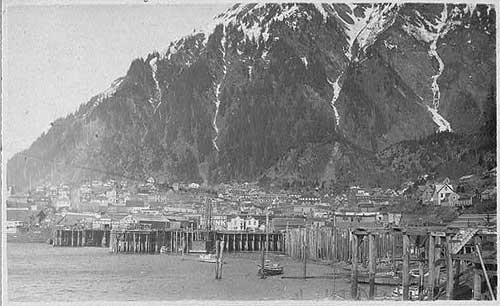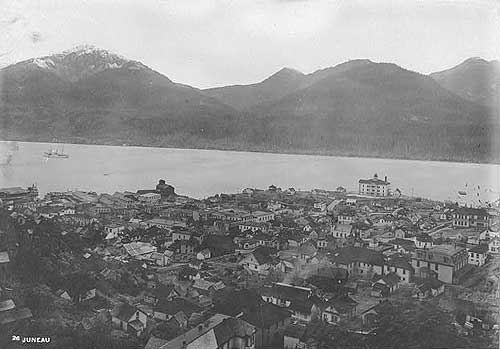
The State Capitol and Its Marble
and keeping the capital in Juneau
By June Allen
October 20, 2004
Wednesday
Ketchikan, Alaska - A recent news item in the Anchorage daily
paper mentioned that a group of Juneau boosters, chaired by Mayor
Bruce Botelho, hope to build a new Alaska Capitol building to
be leased to the state at completion. They call themselves the
Capitol Planning Commission and expect to announce a nationwide
design competition in November. A new Capitol building would
replace Juneau's present six-story Art Deco treasure. The old
six-story building, its imposing façade featuring four
gracious marble columns quarried in Southeastern Alaska, is a
stately structure matching the grandeur of the setting that is
home to picturesque downtown Juneau.
But the still sturdy and timelessly
elegant 75-year-old building obviously needs renovated and perhaps
put to another use. Before that happens, there definitely is
a need for a new Capitol to replace it. The historic building's
age and shortcomings could very well be used as the target and
political banner waved for yet another capital move effort by
Anchorage area interests. But that's politics and this is a story
of a building and of the region its marble adornments came from.
 The 75-year-old Alaska
Capitol and its marble...
The 75-year-old Alaska
Capitol and its marble...
State of Alaska
Alaska's Capitol building was designed and built in 1929-30 for
a legislative body of only eight senators and 16 representatives
who met every other year for 60 days. In those days only the
third floor was occupied by the offices of the territorial governor,
the lieutenant governor (called the Secretary of Alaska back
then) plus the territorial auditor, treasurer and highways engineer
and the legislative chambers! Legislators back then
and even until the oil boom didn't have staff, much less
offices in the Capitol!
The rest of the brand new building provided space for the Alaska
Communications System in the basement, a stylish new post office
on the first floor, and the museum shared the second floor with
a variety of federal offices. The third floor, as mentioned,
was devoted to the territory. The upper stories were for more
federal offices, the U.S. District Court, offices of the U.S.
Attorney, Marshal and so forth. Because of all that, the Alaska
State Capitol was called, in its early years, simply "the
federal building" leading those who came along later
to believe it was built just as an office building, not the stately
capitol that it was and is.
In the year 2004, the 75-year-old structure is overcrowded with
just our present 20 state senators and 40 state representatives,
their offices and staff offices, meeting and other rooms. The
Legislature now meets for a 120-day session every year.
Because of all these needs, the original large rooms have been
made into several small rooms that have lost, in all the remodeling,
the lovely woodwork and trim of the original building. The present
Capitol also lacks a number of things necessary to modern comfort,
including not only simple elbow room, but wiring and dependable
heat and air-conditioning - not to mention adequate parking.
Our old Capitol building also has an amusing early history, a
typical tale of ups and downs solved by pioneer ingenuity. The
U.S. Congress made the initial appropriation for the Capitol
building back in 1911, just days before Territorial status was
conferred in 1912. Juneau, its downtown crowded on a slope under
the backdrop of a giant mountainside, was a small town
of just 4,000 souls then.
 View of Juneau [between
ca. 1900 and ca. 1930]
View of Juneau [between
ca. 1900 and ca. 1930]
Forms part of: Frank and Frances Carpenter collection (Library
of Congress).
Gift; Mrs. W. Chapin Huntington; 1951.
Library of Congress Prints and Photographs Division Washington,
D.C.
The first step in gaining a capitol building was to buy a lot
on which to build it. The federal government, however, refused
to pay what it considered the exorbitant prices wanted by Juneau
property owners! Offers, counter offers and periods of stony
silence went on until the outbreak of World War I, which caused
a further delay of several years. In the 1920s the people of
Juneau, past impatient, were getting disgusted! Once again a
landowner refused to lower his price for a lot, so the people
of Juneau managed to raise the money themselves and the
lot was purchased! Construction began in 1929.
Many Alaskans of that era and there were a mere 60,000
in all of Alaska then,
were well aware of the Territory's wealth of minerals of all
kinds they were prospectors themselves. When the plans
for the new capitol/office building came up, it was only natural
that they wanted Alaska's marble included in the design. By that
time there were at least 70 major buildings across the nation
adorned by Alaska's lovely stone, said to equal that produced
in Carrara, Italy. Gold seekers had found it.
As the Gold Rush stretched into the opening years of the 20th
Century, prospectors scoured not only the mainland portions of
Alaska but the Southeastern mainland and islands of the Alexander
Archipelago as well. Prince of Wales Island, the southernmost
in the chain, is also the largest! It is the third largest island
under the Stars and Stripes after Hawaii and Kodiak. It encompasses
2,231 square miles and 1,427,659 acres, with a shoreline of 990.1
miles!
As early as 1899 the Vermont Marble Co. in far-off New England
began getting letters from Alaska prospectors who told of mountains
of marble, with the information that the stone was near shipping
lanes and less than a thousand miles from Seattle. A Vermont
Marble Co. report of 1905 states, "Letters, of course, were
very vague and indefinite and contained no reliable information.
They all spoke of mountains of marble, quantity beyond calculation
and a quality to which no other marble in the world was superior."
Time proved that there are indeed mountains of marble on Prince
of Wales Island, and the marble is indeed of superior quality
and color!
Marble comes from the shells and exoskeletons of marine
animals, deposited in limestone, buried by other sediment and
then melted, usually by the heat of volcanic intrusions, and
then solidified. The characteristic swirls and veins of marble
varieties are due to various mineral impurities. There are marble
deposits throughout Southeastern. The state's Department of Natural
Resources reports that 56 deposits of limestone and marble occur
adjacent to the coasts of the islands of Southeastern Alaska.
There is even an entire island of marble called, appropriately,
Marble Island; there reportedly are hundreds of huge blocks still
lying on the island, left from the days of active quarrying.
In some locations there are reported to be ancient petroglyphs
carved into the marble deposits.
The first marble ever quarried in Alaska is said to have come
from Ham Island near Wrangell before the turn of the 20th Century.
The Stikine Tlingits carved tombstones from the lovely stone.
Not too many years ago there was a small carved marble
gravestone/totem standing in the side yard of the old two-story
Saxman house that sat just off the highway. Revillagigedo Island,
on which Ketchikan is located, has marble deposits, too.
Pilots remember noticing gleaming white logging roads paved with
crushed marble winding through the south end of the island, roads
that were soon hidden when the quickly-recovering rain forest
covered the scars.
 View of Juneau, mountains
and cabelship (sic) "Burnside" in channel
View of Juneau, mountains
and cabelship (sic) "Burnside" in channel
[between ca. 1900 and ca. 1930]
Forms part of: Frank and Frances Carpenter collection (Library
of Congress).
Gift; Mrs. W. Chapin Huntington; 1951.
Library of Congress Prints and Photographs Division Washington,
D.C.
In the Ketchikan library there is filed an old ledger of the
Vermont Marble Co. titled "Record of Vermont Marble Company's
Interest in Alaska up to and Including 1915." The ledger
includes reports of exploration, site data, competitor activity
and correspondence from a ten-year period of activity. The information
indicates that Vermont Marble Co. did not doubt the presence
of marble in Alaska, but moved slowly to gain information before
investing in any operation. The notes also mention sketchy facts
about two small companies already in the field.
On Marble Island also sometimes called Fox Island
was a producing marble quarry that had begun operation sometime
before 1905. It had been prospected and run by a Mr. Fox and
one of his partners, a Mr. Ball. Another small company called
Great American, in an ownership dispute, sent a Mr. Deppe to
re-stake the claim. In early Alaska fashion, Ball shot Deppe
- and was sentenced to twelve years in prison! Whether or not
this incident had anything to do with it, in 1905 the Vermont
Marble Co. which had someone going out to the Pacific Coast
anyway instructed G.C. Robinson to head north to Alaska
and look over Prince of Wales marble possibilities.
Robinson set sail that autumn on the vessel Dolphin out
of Seattle, headed for Wrangell. Robinson was at first disconcerted
by being sold a ticket only as far as Ketchikan, being told that
the ship called only at Ketchikan and then Juneau. He and other
passengers are said to have persuaded the captain to stop at
Wrangell as well. There he engaged a small gas boat for the crossing
to Prince of Wales. It was October of 1905, bad weather and high
seas. His report, included in the old company ledger, dryly suggests
that any future trips be made in the summer and in larger boats!
Robinson's first stop was at Calder, where Alaska Mining employed
18 men. Calder's supply center was nearby Shakan, a cannery and
sawmill town of 150 souls at the time. He reported excellent
quarry equipment, a sturdy dock and an experienced supervisor
who had previously worked for Vermont Marble Co.! Robinson also
reported that there was indeed a mountain of marble running a
couple of miles alongshore and rising to the tops of 3500-foot
mountains!
Historical note: That Calder operation shut down in 1910, but
the quarry was reopened in 1926 long enough to quarry the stone
to be used in the Washington State Capitol Building!
After leaving Calder, Robinson traveled to the El Capitan operation
some nine miles to the southwest and reported that ocean liners
probably could not access the area. From there he went to Marble
(or Fox) Island, estimating the excellent marble deposits there
to be to be five to six miles long and two to three miles wide.
It was on Marble Island that Vermont Marble Co. finally began
to build in 1909, working with Mr. Fox. A post office was established
and named Tokeen after a nearby Bay. Laborers made $2 a day,
equal to $41 in today's dollars, and operators made $3 a day,
$61 today, plus board.
In 1913 darker deposits were found, prized for trim, and by 1914
there were 70 to 110 men employed there! Their Tokeen camp boasted
bunkhouse reading rooms and three bathrooms! The old Vermont
Marble Co. ledger entries ended in 1915. War was brewing in Europe,
and wars always halt mining operations. And then, after World
War I, architectural styles changed greatly. Marble fell out
of fashion and architects chose concrete as their building material
for the more modern designs.
It is Tokeen marble that adorns Alaska's Capitol building in
Juneau. Some time
between the first 1911 appropriation of funds and eventual construction
process that began in 1929 the quarrymen chose the stone for
the building's exterior columns and interior trim. The Capitol
was dedicated Feb. 2, 1931, in time for 10th Territorial Legislative
session which convened March 2, 1931, under Gov. George Parks.
The historic marble will grace that public building for many
more years to come. If Juneau's Capitol Planning Commission succeeds
in its endeavor to build a new Capitol, the old building can
be renovated, restored to its original grandeur, and used for
many other State of Alaska purposes.
Perhaps a building from your hometown boasts Alaska marble:
|
Vancouver, B.C.
Pacific Building
Rogers Building
Seattle WA
Arctic Club
Hoge Building
Lyons Building
Haight Building
L.C. Smith Building
Bank of California Building
McCormick Hotel
King County Courthouse
Tacoma WA
National Realty Building
Perkins Building
Tacoma Building
Bellingham WA
United States Post Office
North Yakima WA
United State Post Office
Walla Walla WA
Walla Walla County Courthouse
Portland OR
Spaulding Building
Wilcox Building
Yeon Building
Selling Building
Lippman Wolfe Building
Oregon Journal Building
Multnomah Building
Stevens Building
The Dalles OR
The Dalles County Courthouse
San Francisco CA
Flatiron Building
Odd Fellows Building
Sharon Estate Building
Hobart Building
|
Oakland CA
Federal Realty Building
Bankers Investment Building
Realty Syndicate Building
Oakland Manual Training School
Harrison Hotel and Apartments
Sacramento CA
Capital National Bank Building
Forum Building
Travelers Hotel
Fresno CA
Griffith McKenzie Building
Rowell Building
Los Angeles CA
Black Building
Los Angeles Investment Building
Title Insurance and Trust Building
Van Nuys Building
Brockman Building
Community Mausoleum, Inglewood
Haas Building
Hollingworth Building
Merchants National Bank Building
Marsh-Strong Building
Southern Pacific Passenger Station
San Diego CA
Central Mortgage Building
Spreckels Theater
United States Post Office
ªSanta Rosa CA
Community Mausoleum
|
Presidio
CA
United States General Hospital
Modesto CA
Community Mausoleum
Honolulu Hawaii
Pearl Harbor Naval Hospital
Boise ID
State Capitol
Gem Building
Moscow ID
United States Post Office
Lewiston ID
United States Post Office
Salt Lake City UT
Walker Building
National City Bank Building
Empress Theater
Newhouse Hotel
Ogden UT
Eccles Building
Great Falls Montana
Ford Commercial Building
St. Paul MN
Great Northern Railway Building
Pittsburgh PA
City and County Building
Philadelphia PA
Finance Building
Boston Mass.
Orpheum Theater |

june@sitnews.org
Copyright © 2004
June Allen
All rights reserved.
Not to be reprinted in any form without the written permission
of June Allen.
Post a Comment View Comments
Submit
an Opinion - Letter
Sitnews
Stories In The News
Ketchikan, Alaska
|









